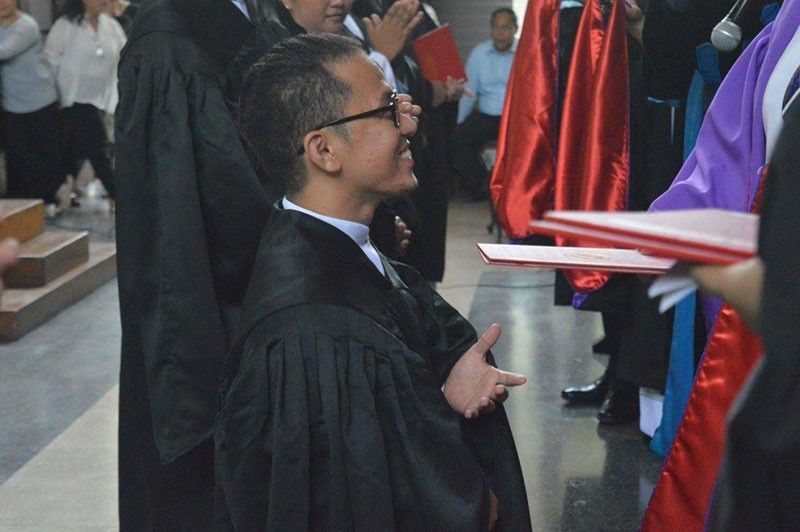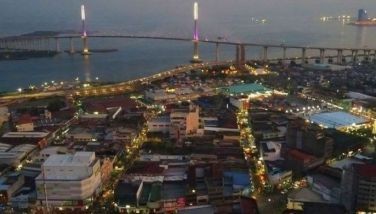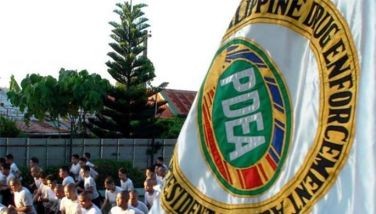(JUVENILE DELINQUENCY) Second chances

CEBU, Philippines — Some 20,584 minors surrendered to local police offices in the Philippines within two months since President Duterte stepped into power in 2016, data from the Philippine National Police’s Women and Children Protection Center (WCPC) showed.
Of the total, 3,971 were children from Central Visayas.
Cebu City Police Office data revealed that the number of juvenile delinquents increased last year to 92 compared to 82 in 2017. The figures were based on a three-month trend from August 1 to October 31, 2017 and the same period in 2018.
Children were mostly involved in thefts with 39 incidents recorded, a jump from last year’s 19.
Cases involving illegal drugs decreased from 33 to 24; acts of lasciviousness increased from zero to four; attempted murder from zero to three; illegal possession of deadly weapon from zero to one; frustrated homicide from one to two; frustrated murder from one to zero; cattle-rustling from one to two; selling or using volatile substance from five to one; qualified theft from zero to two; illegal possession of firearms from three to two.
Those arrested for special laws reached 14.
The proposed House Bill (HB) 8858 seeks to lower the minimum age of criminal responsibility from the current 15 years old to 12 years old. The amendment includes a provision that 12 years old and above but below 18 years old shall be exempt from liability, except civil liability.
CICL 12 years old and above but below 18 years old and who have been determined to have acted with discernment shall be subjected to appropriate intervention and diversion proceedings.
These youth offenders should be subjected to a community-based intervention program supervised by the local social welfare and development officer.
Yet for local Catholic leaders, the rising statistics is not enough alarm to justify dropping the age of criminal liability.
Cebu Archbishop Jose Palma, like other Catholic prelates, disapproves of the proposal, saying a simple solution will not work for complex ideologies.
“Perhaps the solution is in addressing the issue from other perspectives rather than just giving a simplistic answer as if when you lower the age, automatically all the children will try to be good,” he said.
“In general, we the Catholic bishops don’t agree with it. Personally, I don’t agree with it,” he added.
Senior Supt. Royina Garma, the top brass at CCPO, agrees because “a child is always a child.”
Garma said that rather than focusing on the age and the child, the package of rehabilitative service should be looked into first.
Without improving the quality of psychosocial service given to children at risk (CAR) for crimes, and children in conflict of the law (CICL), she said the vicious cycle of survival cannot be broken.
“It’s a way of survival doing illegal. Kapag umiyak ang anak, ‘Mama, pagkain,’ gagawan mo talaga ng paraan or else the child will find a way, even if it means selling drugs,” Garma said.
She suggested that parents, as first teachers, should lead by example. She said children are most absorbent in their cognitive stages and tend to imitate the actions of the adults in their immediate environment.
“We always look at the issue of security, ‘walang pulis kaya may nagnanakaw’ but we have to go back sa basic. Why in Japan? Kahit walang pulis walang nagnanakaw? Because of values. Wala sa pulis ang krimen. It is based on values, and how you are brought up,” she said, adding that environment comes next as reason why children resort to crimes.
Dr. Anna Kathrina Oaminal-Watin, a clinical psychologist, said she is in favor of the measure for as long as the amendments like the mandatory rehabilitation of these young offenders will be strictly implemented to the fullest extent.
“Philippine mental health professionals remark that ‘the typical CICL is poor, lacking in education, a victim of parental neglect and/or abuse, and lives in a criminogenic environment (PAP, 2017).’ In a paper by Amantra and Barzman (2012), they pointed out that traumatized children are at greater risk for delinquency due to the impact of the trauma to one’s attitude and skills,” reads the position paper of Watin.
She said there is a need for the government to implement an intervention for the holistic rehabilitation of CICL.
Other amendments that she is amenable to are: CICL above 12 years old up to 18 years old who commit serious crimes (such as parricide, murder, infanticide, rape, among others) shall be mandatorily placed in ‘Bahay Pag-Asa’ for rehabilitation; the ‘Bahay Pag-Asa’ shall be under the jurisdiction of the Department of Social Welfare and Development (DSWD) and its funding shall be included in the budget of the DSWD in the Annual General Appropriations Act; and the penalty to be imposed upon CICL shall always be two degrees lower compared to when an adult committed; for crimes punishable by life imprisonment, the maximum length of imprisonment to be imposed shall be 12 years.
“If the CICL reach 18 years old and still do not reform, that is the only time they shall be sent to agricultural camps or training centers. Upon reaching 25 years old, they shall be set free, whether or not the sentence was completed. These camps will be supervised by the DSWD, the Bureau of Corrections, and the Technical Education and Skills Development Authority,” Watin added.
She said there is also a need for the parents or guardians of the CICLs shall undergo mandatory intervention program.
Watin also mentioned the stand of the Psychological Association of the Philippines, which is against on the proposal.
The association called for the strengthening of the juvenile justice system instead through the strict implementation of the existing laws that prosecute adults who coerce children to engage in criminal behavior.
PAP believes that the adolescent brain is still under development, stressing that the significant changes in brain anatomy and activity are still taking place in the (prefrontal) regions that govern impulse control, decision-making, long-term planning, emotion regulation, and evaluation of risks and rewards.
It added that these abilities, which are involved in criminal behavior, do not fully form until young adulthood, making early and middle adolescents (ages 12-16) especially vulnerable to risky and reckless behavior.
“The adolescent is psychosocially immature compared to adults. Because of still developing cognitive abilities and limited life experiences, adolescents are less able and less likely than adults to consider the longer-term consequences of their actions,” the group said.
In Cebu City, the Community Scouts Youth Guidance Center and Operation Second Chance house children in conflict with the law 18 years old and below.
“Community Scouts came before Operation Second Chance and was already a project of the police. Because at that time these minors before they will be committed to the operation second chance they have no place to go,” said assistant city administrator Annabeth Cuizon.
One of the objectives of the Community Scouts is to rehabilitate the CICLs. Cuizon said the police started this in 1980s.
Before becoming a legislator, City Councilor Margarita Osmeña was a volunteer-member for the Cebu City Task Force Street Children.
She started the Children of Cebu Foundation which became part of the task force.
Cebu City Task Force on Street Children is the umbrella organization of all child-caring agencies in Cebu City, whether government organization or non-government organizations.
When Osmeña became a member because of Children of Cebu Foundation, Cuizon recalled that the members of the foundation told her that the city did not have a drop-in center for children or a processing center for street children.
Cuizon said that was where Pari-an Drop-in Center, which she was part of since 1992, started.
“It is a processing center. So, every time the police, the social worker, brings a street child there, they will facilitate. They conduct case study survey. So nahimo na siyang processing center, half-way house from the center to a more permanent rehabilitation center,” she said.
Once there’s a CICL referred to the drop-in center, Cuizon said, it will go directly to community scouts which is a temporary shelter.
“Sa social worker sa Pari-an, ilang pirmirong buhaton is to contact the parents. SOP gyud na nga ang parents and relatives kay kung naa pa gali nay relatives or parents, balik gyud na sa ginikanan rather than referring them to a permanent shelter,” she said.
“Ang Operation Second Chance, that started because at that time the Cebu City Task Force Street Children together with Atty. Esperanza Valenzona at that time of Share a Child movement which is a member of Cebu City Task Force Street Children, they had weekly visitations at BBRC,” she said.
Seeing that minor offenders were mixed with adult criminals, something needed to be done.
Thus the Operation Second Chance became the benchmark of that law.
With the impending conversion of Operations Second Chance to a Bahay Pag-Asa, Cuizon said the center will not only cater CICLs with court order but also serve as a holding area for CICLs.
Osmeña said the city government has established a center for the youth offenders, the Operations Second Chance, way ahead of any LGUs.
“We already have youth center where a house parent is there and social workers for the rehabilitation of the minor offenders,” said Osmeña, a former chairperson of the Cebu City Task Force for Street Children.
Osmeña said she could not ascertain if there are enough facilities in Cebu to accommodate more children in conflict with the law. But Cebu City, she said, will improve the Operations Second Chance so that it will be at par with a Bahay Pag-asa.
Through the years, these facilities have lived up to their calling with numerous success stories about their beneficiaries minted every year.
Just like the story of Stephen Dano.
After living a life of a young criminal, the turning point of his life finally came in 2007 when he reunited with an old friend who was a beneficiary of the Cebu City Government also has its Community Scouts Youth Guidance Center (CSYGC).
Dano, then 14, was inspired to go back to the facility and for the first time in years, he felt he was at home. He also went back to school through the Alternative Learning System program.
The death of his older brother, aged 18, in 2012 was also Dano’s driving force. The brother, who was jailed for murder, committed suicide inside the prison.
“Mao to nakaingon ko nga kinahanglan gyud ko moeskwela ug maningkamot. Knowledge is power gyud,” said Dano, who at 26 is now the family’s breadwinner.
Years at the facility soon changed his life for the better.
Dano, who used to sell and take illegal drugs and rob people, turned away from his dark world and became a voluntary worker, helping to divert young children away from a life of crime.
His own drug dealing days, he said, are now completely behind him.
“I saw the opportunity to make something of my life. And I took it,” he said.
Dano finished his Bachelor of Elementary Education at the Asian College of Technology in March 2018. He then took the licensure examination for teachers in September that year and passed. He is now a licensed professional teacher.
To pay it forward, the young lad has been working as a community service officer at the CSYGC since 2016 and a volunteer of a faith-based non-government organization, Justice, Peace and Integrity of Creation (JPIC), which shouldered portion of his educational expenses. JPIC is among the benefactors of CSYGC.
He also sits as an officer of the Cebu City Federation for Children. Part of his job is to conduct campaign awareness on juvenile laws and children’s rights in the city’s 80 barangays and training on psychosocial.
Now, Dano advocates that education should be given to children, even those in the slums. He said education is key to alleviating poverty.
He is also teaching part-time for a mobile school, serving the less-privileged children in the villages of Pasil, Tejero, Tinago, and Carreta.
“I am forever grateful that despite my dark background, they have not lost faith and trust in me. I am grateful I was given an opportunity to redeem myself and pick up the pieces of my tumultuous young life,” Dano said.
“I believe that all of us – whether children or adults – deserve another shot at life. We all deserve a second chance.” — JMD (FREEMAN)
- Latest























